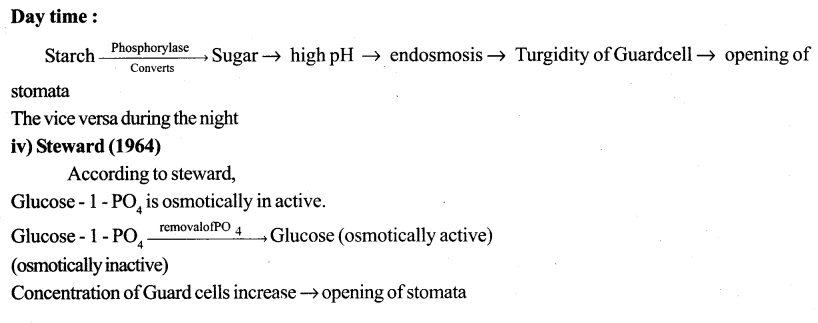Tamilnadu State Board New Syllabus Samacheer Kalvi 11th Bio Botany Guide Pdf Chapter 11 Transport in Plants Text Book Back Questions and Answers, Notes.
Tamilnadu Samacheer Kalvi 11th Bio Botany Solutions Chapter 11 Transport in Plants
11th Bio Botany Guide Transport in Plants Text Book Back Questions and Answers
Part – I
Question 1.
In a fully turgid cell:
(a) DPD = 10 atm; OP = 5 atm; TP = 10 atm
(b) DPD = 0 atm; OP =10 atm; TP = 10 atm
(c) DPD = 0 atm; OP = 5 atm; TP = 10 atm
(d) DPD = 20 atm; OP = 20 atm; TP = 10 atm
Answer:
(b) DPD = 0 atm; OP =10 atm; TP = 10 atm
Question 2.
Which among the following is correct?
i) apoplast is fastest and operate in nonliving part
ii) Transmembrane route includes vacuole
in) Symplast interconnect the nearby cell through plasma desmata
iv) Symplast and the transmembrane route is in the living part of the cell
a) i and ii
b) ii and iii
c) iii and iv
d) i, ii, iii, iv
Answer:
d) i, ii, iii, iv
![]()
Question 3.
What type of transpiration is possible in the xerophyte Opuntia?
(a) Stomatal
(b) Lenticular
(c) Cuticular
(d) All the above
Answer:
(b) Lenticular
Question 4.
Stomata of a plant open due to
a) Influx of K+
b) Effrilx of K+
c) Influx of Cl–
d) Influx of OH–
Answer:
a) Influx of K+
![]()
Question 5.
Munch hypothesis is based on:
(a) translocation of food due to TP gradient and imbibition force
(b) ranslocation of food due to TP
(c) translocation of food due to imbibition force
(d) None of the above
Answer:
(b) ranslocation of food due to TP
Question 6.
If the concentration of salt in the soil is too high and the plants may wilt even if the field is thoroughy irrigated. Explain
Answer:
High salt concentration results in high be osmotic potential of the soil solution, so the plant has to use more energy to absorb water. Under extreme salinity conditions, plants may be unable to absorb water and will wilt even if the surrounding soil is thoroughly irrigated. This is also referred to as the osmotic or water deficit effect of salinity.
![]()
Question 7.
How phosphorylase enzyme open the stomata in starch sugar interconversion theory?
Answer:
- The discovery of enzyme phosphorylase in guard cells by Hanes (1940) greatly supports the starch-sugar interconversion theory.
- The enzyme phosphorylase hydrolyses starch into sugar and high PH followed and the opening takes place during the night.
Day:
1.
2. Photosynthesis occur
3. pH – increased
4. Movement of water from
5. subsidiary cells to guard cells
6. Guard cells become turgid
7. Opening of stomata
Night:
1. 
2. No Photosynthesis
3. pH – lowered
4. Movement of water from guard cells
5. Guard cells become flaccid
6. Closure of stomata
Question 8.
List out the non-photosynthetic parts of a plant that need a supply of sucrose?
Answer:
The non-photosynthetic parts of a plant that need a supply of sucrose:
- Roots
- Tubers
- Developing fruits and
- Immature leaves.
Question 9.
What are the parameters which control water potential?
Answer:
1. Slatyer and Taylor (1960) introduced the concept of water potential.
Definition – water potential is the potential energy of water in a system – compared to pure water when temperature and pressure are kept constant.
2. It is also a measure of how freely water molecules can move in a particular environment or system. Water potential is denoted by the Greek symbol Ψ (psi) and measured in Pascal (Pa). At standard temperature, the water potential of pure water is zero
3. Addition of solute to pure water decreases the kinetic energy thereby decreasing the water potential, from zero to negative.
4. So, Comparatively a solution always has low water potential than pure water. In a group of cells with different water potential, a water potential gradient is generated.
5. Water will move from higher water potential to lower water potential.
When potential ( Ψ) can be determined by. Solute concentration or Solute potential ( Ψs) Pressure potential ( Ψp)
By correlating two factors, water potential is written as (Ψw=Ψs)+Ψp
a) Solute potential (Ψs) or Osmotic potential
- Denotes the effect of dissolved solute on water potential.
- In pure water, the addition of solute reduces its free energy and lowers the water potential value from zero to negative.
- Thus the value of solute potential is always negative. In a solution at standard atmospheric pressure, water potential is always equal to solute potential (Ψw = Ψs ).
b) Pressure Potential (Ψp)
- Pressure potential is a mechanical force working against the effect of solute potential.
- Increased pressure potential will increase water potential and water enters cells and cells become turgid.
- This positive hydrostatic pressure within the cell is called Turgor, pressure likewise, withdrawal of water from the cell decreases the water potential and the cell becomes flaccid.
Question 10.
An artificial cell made of selectively permeable membrane immersed in a beaker (in the figure) Read the values and answer the following questions?
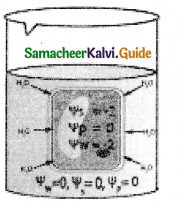
a) Draw an arrow to indicate the direction of water movement
b) Is the solution outside the cell isotonic, hypotonic or hypertonic?
c) Is the cell isotonic, hypotonic, or hypertonic?
d) Will the cell become more flaccid, more turgid or stay in original size?
e) With reference to artifical cell state, the process is endomosis or exomosis? Give reasons
Answer:
a)
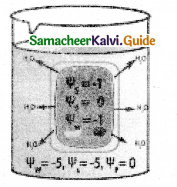
(b) Outside solution in hypotonic.
(c) The cell is hypertonic.
(d) The cell becomes more turgid.
(e) The process is endo – osmosis because the solvent (water) moves inside the cell.
Reason: Endomosis is defined as the osmotic entry of solvent into a cell when it is placed in pure water/Hypotonic solution. The solution in the beaker outside the cell is pure water. ( Ψw = 0), and water enters into the artificial cell which is placed inside the beaker of pure water, (i.e) from hypotonic to hypertonic solution.
Part II
11th Bio Botany Guide Transport in Plants Additional Important Questions and Answers
I – Choose The Correct Answers
Question 1.
In plants, cell to cell transport is aided by:
(a) diffusion alone
(b) osmosis alone
(c) imbibition alone
(d) all the three above
Answer:
(d) all the three above
Question 2.
The smell from a lightened incense stick or mosquito coil or open perfume bottle in a closed room is due to
a) Osmosis
b) Facilitated diffusion
c) Simple diffusion
d) imbibition
Answer:
c. Simple diffusion
![]()
Question 3.
Which of the following statements are correct?
(i) Cell membranes allow water and non-polar molecules to permeate by simple diffusion.
(ii) Polar molecules like amino acids can also diffuse through the membrane.
(iii) Smaller molecules diffuse faster than larger molecules.
(iv) Larger molecules diffuse faster than smaller molecules.
(a) (i) and (iv) only
(b) (i) and (iii) only
(c) (i) and (ii) only
(d) (ii) and (iv) only
Answer:
(b) (i) and (iii) only
Question 4.
Solute potential is also known as
a) Water potential
b) Pressure potential
c) Osmotic potential
d) Maic potential
Answer:
c. Osmotic potential
![]()
Question 5.
The swelling of dry seeds is due to a phenomenon called:
(a) osmosis
(b) transpiration
(c) imbibition
(d) none of the above
Answer:
(c) imbibition
Question 6.
Cell A has an osmotic potential of -20 bars and a pressure potential of +6 bars. What will be its water potential?
a) -14 bars
b) +14 bars
c) -20 bars
d) +20 bars
Answer:
a. -14 bars
![]()
Question 7.
The OP and TP of two pairs of cells A – B, and X-Y are under
a) Cell A: OP=-I0atm, TP=4atm
b) Cell B : OP = l0atm, TP = 6atm
c) Cell X: Op =-l0atm, TP = 4atm
d) CeIlY: OP = -Katm, TP = 4atm
The net movement of water shall be from
a) A toB and X to Y
b) A to B and Y toX
c) B to A and X to Y
d) B to A and Y to X
Answer:
d. B to A and Y to X
Question 8.
Water potential is influenced by which of the two factors among the given four
I) Concentration
II) Pressure
III) Temperature
IV) gravity
a) I & II
b) II & III
c) III & IV
d) I & IV
Answer:
a) I & II
![]()
Question 9.
………………………. is equal to TP and is positive except plasmolysed cell and in xylem vessel where it is negative
a) Water potential
b) Pressure potential
c) Solute potential
d) Hydrostatic potential
Answer:
b. Pressure potential
Question 10.
Diffusion Pressure Deficit (DPD) was termed by Meyer in:
(a) 1928
(b) 1828
(c) 1936
(d) 1938
Answer:
(d) 1938
![]()
Question 11.
Imbibants present in plants are generally
a) Hydrothermic
b) Hydrostatic
c) Hydrophilic
d) Hydrophobic
Answer:
c. Hydrophilic
Question 12.
Kramer (1949) recognised two distinct mechanisms, which independently operate in the absorption of water in plants are:
(a) osmosis and diffusion
(b) imbibition and diffusion
(c) diffusion and absorption
(d) active absorption and passive absorption
Answer:
(d) active absorption and passive absorption
![]()
Question 13.
Root pressure is totally apsent in Gymnosperms because
a) Trachea absent
b) Tracheids absent
c) Trees are tall
d) Trees are comparatively short
Answer:
a. Trachea absent
Question 14.
When respiratory inhibitors like KCN, chloroform are applied:
(a) there is a decrease in the rate of respiration and an increase in the rate of absorption of water.
(b) there is an increase in the rate of respiration and a decrease in the rate of absorption of water.
(c) there is a decrease in the rate of respiration and also a decrease in the rate of absorption of water.
(d) there is an increase in the rate of respiration and also in the rate of absorption of water.
Answer:
(c) there is a decrease in the rate of respiration and also a decrease in the rate of absorption of water.
![]()
Question 15.
Find the DPD in a flaccid cell if its OP is 10
a) 20
b) 30
c) 10
d) 40
Answer:
c.10
Question 16.
Pulsation theory was proposed by:
(a) Strasburger
(b) Godsey
(c) J.C. Bose
(d) C.V. Raman
Answer:
(c) J.C. Bose
![]()
Question 17.
When a cell is kept in 0.5m solution of sucrose it’s volume does not alter. If the same cell is placed in 0.5M solution of sodium chloride, the volume of the cell
a) Increase
b) Decrease
c) cell will be pIasrnoysed
d) Will does not show any change
Answer:
d. Will does not show any change
Question 18.
Indicate the correct statements:
(i) Root pressure is absent in gymnosperms.
(ii) Root pressure is totally absent in angiosperms.
(iii) There is a relationship between the ascent of sap and root pressure.
(iv) There is no relationship between the ascent of sap and root pressure.
(a) (i) and (ii)
(b) (ii) and (iii)
(c) (ii) and (iv)
(d) (i) and (iv)
Answer:
(d) (i) and (iv)
Match The Following & Find Out The Correct Order
Question 19.
I) Water potential – A) Turgor pressure
II) Solute potential – B) Osmotic potential + Pressure potential
III) Matric potential – C) Osmotic potential
IV) Pressure potential – D) Imbibition pressure
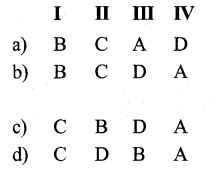
Answer:
b) B C D A
Question 20.
I) Leaves – A) Antitransport
II) Seed – B) Transpiration
III) Roots – C) Negative osmotic potential
IV) Aspirin – D) Imbibition
V) Plasmolyced cell – E. Absorption
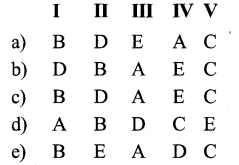
Answer:
a) C B D E A
Question 21.
I) Transport of substance from a region of lower concentration to a region of higher concentration is with the expenditure of energy – A. Antiport
II) The movement of two types of molecules across the membrane in opposite direction – B. Symport The movement of a molecule across III) a membrane independent of other molecules – C. Active port
IV) The movement of two types of molecules across the membrane in the same direction – D. Uniport
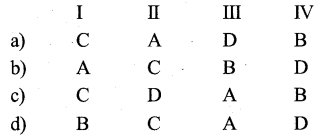
Answer:
c) C D A B
![]()
Question 22.
I) Passive transport – A) Uphill transport
II) Active transport – B) Short distance transport
HI) Cell to cell transport – C) Long-distance transport
IV) Ascent of sap – D) Downhill transport
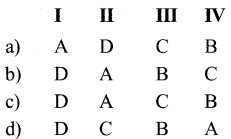
Answer:
b) D A B C
Question 23.
The length and breadth of stomata is:
(a) about 10 – 30μ and 2 – 10μ respectively
(b) about 10 – 14μ and 3 – 10μ respectively
(c) about 10 – 40μ and 3 – 10μ respectively
(d) about 5 – 30μ and 5 – 10μ respectively
Answer:
(c) about 10 – 40μ and 3 – 10μ respectively
Question 24.
A membrane that permits the solvent and not the solute to pass through it is termed is
a) Permeable,
b) impermeable
c) semipermeable
d) differentially permeable
Answer:
c. Semi permeable
![]()
Question 25.
Who did observe that stomata open in light and close in the night:
(a) Unger
(b) Sachs
(c) Boehm
(d) Von Mohl
Answer:
(d) Von Mohl
Question 26.
The phosphorylase enzyme in guard cells supports the starch-sugar interconversion theory. The above reaction is:
(a) oxidation reaction
(b) hydrolyses reaction
(c) reduction reaction
(d) none of the above
Answer:
(b) hydrolyses reaction
![]()
Question 27.
If a cell kept in a solution of unknown concentration gets deplasmolysed the solution is
a) hypotonic
b) hypertonic
c) isotonic
d) detonic
Answer:
a. hypotonic
Question 28.
A cell placed in a strong salt solution will shrink because
a) the cytoplasm will decompose
b) mineral salts will break the cell wall
c) salt will leave the cell
d) water will leave by exosmosis
Answer:
d. water will leave by exosmosis
![]()
Question 29.
Phenyl Mercuric Acetate (PMA), when applied as a foliar spray to plants:
(a) induces partial stomatal closure for two weeks.
(b) induces partial stomatal opening for two weeks.
(c) induces partial stomatal closure for four weeks.
(d) induces stomatal closure permanently
Answer:
(a) induces partial stomatal closure for two weeks.
Question 30.
The osmotic pressure of cell sap is maximum in
a) Hydrophytes
b) Halophytes
c) Xerophytes
d) Mesophytes
Answer:
b. Halophytes
![]()
Question 31.
Say true or false and on that basis choose the right answer.
I) In facilitated diffusion, molecules move across the cell membrane with the help of special proteins, with the expenditure of energy
II) Porin is a larger transport protein, facilitates smaller molecules to pass through.
III) Aquaporins are recognized to transport urea, CO2, NH3 metalloid & ROS
IV) The carrier proteins structure does not get modified due to its association with the molecules
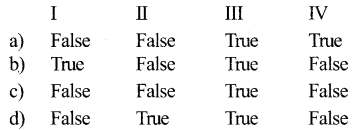
Answer:
d. False True True False
Question 32.
I) Hypertonic is a strong solution (low solvent/high solute/ low Ψ )
II) Hypotonic is a weak solution (high solvent/low or zero solutes/ high Ψ)
III) Hypertonic is the weak solution (high solvent/low or zero solutes/high Ψ)
IV) Hypotonic is a strong solution (low solvent / high solute/low Ψ)
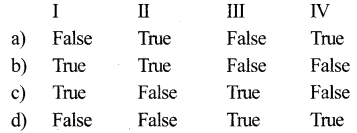
Answer:
b. True True False False
![]()
Question 33.
From sieve elements sucrose is translocated into sink organs such as root, tubers etc and this process is termed as:
(a) Xylem unloading
(b) Xylem uploading
(c) Phloem unloading
(d) Phloem uploading
Answer:
(c) Phloem unloading
Question 34.
The value of pure water is zero in which three aspects of the given options
I) Osmotic pressure
II) Osmotic potential
III) Water potential
IV) Pressure potential
a) I, II, & III
b) II, III & IV
c) I, Ill & IV
d) I, II & IV
Answer:
a. I, II & III
![]()
Question 35.
Gases such as oxygen and carbon dioxide cross the cell membrane by
a) Passive diffusion through the lipid bilayer
b) Primary active transport
c) Specific gas transport proteins
d) Secondary active transport
Answer:
Question 36.
Hydathodes are generally present in plants that grow in:
(a) dry places
(b) moist and shady places
(c) sunny places
(d) deserts
Answer:
(b) moist and shady places
![]()
Question 37.
Why sugars are transported in the form of su-crose in phloem?
a) It is inactive and highly soluble
b) It is active
c) It yields high ATP
d) It is lighter in weight.
Answer:
a. It is inactive and highly soluble
Question 38.
Unloading of pholem at sink includes
a) Passive transport
b) diffusio
c) Osmosis
d) Active transport
Answer:
d. Active transport
![]()
Question 39.
The liquid coming out of the hydathode of grasses is:
(a) pure water
(b) not pure water
(c) a solution containing a number of dissolved substances
(d) saltwater
Answer:
(c) a solution containing a number of dissolved substances
Question 40.
In a flaccid cell
a) DPD = OP
b) DPD = TP
c) TP = OP
d) OP = O
Answer:
a. DPD = OP
![]()
Question 41.
The pathway of water movement involving living part of a cell is
a) Apoplast pathway
b) symplast pathway
c) Transmembrane pathway
d) Lateral conduction
Answer:
b. Symplast pathway
Question 42.
The ascent of sap is
a) Upward movement of water in plants
b) downward movement of water in plants
c) upward and downward movement of water plants
d) None of the above
Answer:
a. upward movement of the water plants
![]()
Question 43.
High tensile strength of water is due to
a) Adhesion only
b) cohesion only
c) Both (a) and (b)
d) None of these
Answer:
c. Both (a) and (b)
Question 44.
Maximum transpiration occur in
a) Mesophytes
b) Xerophytes
c) Hydrophytes
d) Epiphytes
Answer:
a. Mesophytes
![]()
Question 45.
Supply ends in transport of solutes are
a) green leaves
b) root and stem
c) xylem and phloem
d) Hormones and enzymes
Answer:
c. Xylem and phloem
Question 46.
For guttation in plants, the process responsible is
a) Root pressure
b) Atmospheric pressure
c) Imbibition
d) None of these
Answer:
a. Root pressure
![]()
Question 47.
Which of the following theories for Ascent of sap was proposed by famous Indian scientist. J.C. Bose.
a) Transpiration pull theory
b) Pulsation theory
c) Root pressure theory
d) Atmospheric pressure theory
Answer:
b. Pulsation theory
Question 48.
Which of the following plant material is an efficient water imbibant?
a) Lignin
b) Pectin
c) Cellulose
d) Agar
Answer:
d. Agar
![]()
Question 49.
Which of the following helps in the Ascent of sap?
a) Root pressure
b) Transpiration
c) Capillarity
d) All the above
Answer:
d. All the above
Question 50.
In a girdled plant which of the following dies first?
a) Shoot
b) root
c) Both die simultaneously
d) None – the plant survives
Answer:
b. root
![]()
Question 51.
Assertion:-A Imbibition is also diffusion
Reason -R The movement of water in the above process is along a concentration gradient.
a) Both A and Rare true and R is correct explanation of A
b) Both A and R are true but R is not the correct explanation of A
c) A true but R false
d) Both A and Rare false
Answer:
a) Both A and R are True and R is correct explanation of A
Question 52.
Assertion: – A In rooted plant, the transport of water and minerals in xylem is essentially multi-directional
Reason – R Organic compound and nuitrient undergoes undirectional transport only
Answer:
d) Both A and R are false
![]()
Question 53.
Assertion: – A The adsorption of water by solid particles of an adsorbant with out forming a solution is known as imbibition
Reason: – R The liquid which is imbided is known as imbibate
Answer:
b) Both A and R are true but R is not the correct explanation of A
Question 54.
Assertion: – A In phloem loading, food is transported to the sink
Reason – R Food is transported from source to sink ‘
Answer:
d) Both Assertion ‘A’ and Reason ‘R’ are false
![]()
Question 55.
Assertion – A: Xylem a principal water conducting ’
Reason -R: It has been recognised by girdling or ringing experiments
Answer:
a) Both A and R are True R is the correct explanation of A
Question 56.
Assertion: – A In phloem, sugar are translocated in non reducing form
Reason – R Non reducing sugars are most reactive sugars
Answer:
c) Assertion is true but Reason is false
![]()
Question 57.
Assertion: AIn ringing experiment a narrow continuous band of tissues external to the phloem is removed
Reason: R Ringing experiment proves that phloem is involved in water transport ’
Answer:
d) Both A and R are false
II. Two Mark Questions
Question 1.
What is the need for the transport of materials in plants?
Answer:
Water absorbed from roots must travel up to leaves by xylem for food preparation by photosynthesis. Likewise, food prepared from leaves has to travel to all parts of the plant including roots.
Question 2.
What is osmosis
Answer:
It is a special type of diffusion almost same like simple diffusion but has a selectively permeable membrane is here, through which osmosis occur.
(OR)
It is the movement of water molecules from a place of its higher concentration, to the place of its lower concentration through a semipermeable membrane.
![]()
Question 3.
Define the term diffusion.
Answer:
The net movement of molecules from a region of their higher concentration to a region of their lower concentration along a concentration gradient until an equilibrium is attained.
Question 4.
The touch me plant closes its leaves at the touch – Explain.
Answer:
- In the ‘Touch me not’ plant the touching act as stimulus, and it closes the leaves.
- When we touch the plant, at that time the stem releases some chemicals, which force water to move out of the cell leading to the loss of Turgor pressure and the leaves droop down However after sometime they become normal.
![]()
Question 5.
What is meant by Porin?
Answer:
Porin is a large transporter protein found in the outer membrane of plastids, mitochondria and bacteria which facilitates smaller molecules to pass through the membrane.
Question 6.
Define water potential
Answer:
- The potential energy of water in a system compared to pure water when both temperature and pressure are ketp same.
- It is a measure of how freely water molecules can move in a given environment
- Water potential of pure water is = 0
Question 7.
Define Diffusion Pressure Deficit.
Answer:
- Termed by Meyer (1938)
- The difference between the Diffusion pressure of the solution and its solvent at a particular temperature and atmospheric pressure of the solution and its solvent at a particular temperature and atmospheric pressure is called DPD.
![]()
Question 8.
Differentiate between short distance and Long Distance Transport.
Answer:
| SDT | LDT |
| 1. Cell to cell Transport Involve few cells ni lateral direction |
Transport with in the network of xylem and phloem |
| 2. Connecting link to xylem bind phloem from root hairs to leaf tissues | Direct vertical – main Transport |
| 3. Eg. Diffusion, Osmosis etc | 4. Eg. Ascent of sap & Translocation of solutes. |
Question 9.
Differentiate between Passive & Active Transport
Answer:
| PT | AT |
| 1. Down hill Transport (Phyical) | Up hill Transport (Biological) |
| 2. Occur According to concentration gradient | Occur against concentration gradient |
| 3. No expenditure of energy | There is expenditure of energy obtained from Respiration |
| 4. Eg. Diffusion – Facilitated Diffusion osmosis etc. | Eg. Na+ K+ ATP are pump. |
Question 10.
Give two examples of the phenomenon of Imbibition.
Answer:
two examples for the phenomenon of Imbibition:
- The swelling of dry seeds.
- The swelling of wooden windows, tables, doors due to high humidity during the rainy season.
![]()
Question 11.
Explain carbonic Acid Exchange theory.
Answer:
- Soil solution act as a medium of ion-exchange
- The CO2 released by roots combine with water to form carbonic acid (H2CO3)
- Carbonic acid dissociates into H+ + HCO3 in the soil solution.
- H+ ions exchange with cations adsorbed on clay particles and cations from micelles get released int c.
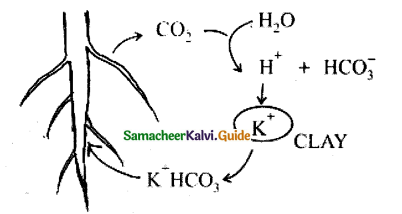
Question 12.
Give Answer in a sentence or two Distinguish between (i) Exomosis & Endomosis (ii) Apoplast & Symplast (iii) Cohesion & Adhesion (v) Influx & Efflux
Answer:
| I) Exomosis | Endomosis |
| The osmotic outflow of water, when cell placed in hypertonic solution | Osmotic inflow into the cell when placed in hypotonic solution or water |
| Eg. Preservation of Jam, Jellies, pickles | Eg. Swelling of Dry grapes placed in water |
| II) Apoplast | Symplast |
| System of adjacent cell walls – continuous throughout except at the asparian strips of endodermis in the roots | System of interconnected protoplasts of neighbouring cells in plants |
| III) Cohesion | Adhesion |
| Attraction between molecules of a similar kind | The attraction between molecules of different kind |
| IV) Influx | Efflux |
| The entry of ion into the cell is known as Influx | The exit of ion from the cell into outside is known as Efflux |
| It can be active or passive | It can be active or passive. |
Question 13.
What is meant by osmotic pressure?
Answer:
When a solution and its solvent (pure water) are separated by a semipermeable membrane, the pressure is developed in the solution, due to the presence of dissolved solutes. This is called osmotic pressure (OP).
![]()
Question 14.
Define Root Pressure.
Answer:
- Stephen Hales – coined the term
- Stoking (1956) Defined the term.
- A pressure developing in the tracheary elements of the xylem as a result of metabolic activities of the root.
Question 15.
Define the term osmosis.
Answer:
Osmosis (Latin: Osmos – impulse, urge) is a special type of diffusion. It represents the movement of water or solvent molecules through a selectively permeable membrane from the place of its higher concentration (high water potential) to the place of its lower concentration (low water potential).
Question 16.
Why plants transport sugars as sucrose and not as starch or Monosaccharide (Glucose & Fructose)
Answer:
| Name | Type | Properties |
| 1.Starch | Polysaccharide (non reducing sugar) | Insoluble in water cann’t be transport |
| 2. Glucose & Fructose | Monosaccharides (reducing sugar) | Soluble in water but less efficient in energy storage & reactive |
| 3. Sucrose | Disaccharide(non reducing sugar) | Soluble in water, even at high concentration, low viscosity, more efficient in energy storage no reducing ends make it inert than glucose & Fructose. |
Question 17.
What are the three types of plasmolysis?
Answer:
Three types of plasmolysis occur in plants:
- Incipient plasmolysis
- Evident plasmolysis
- Final plasmolysis.
![]()
Question 18.
Identify the diagram and Neatly label the parts
Answer:
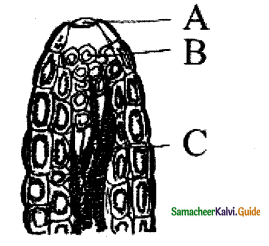
The given diagram is the structure of Hydathode
A-Guard cell
B-Epithem
C-Tracheids
Question 19.
Identify the Diagram & Label the parts.
Answer:
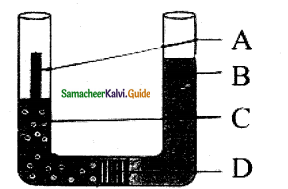
The given diagram explain Reverse osmosis
A – Pressure
B – Pure water
C – Saltwater
D – Membrane
![]()
Question 20.
Differentiate between Ascent of sap and Translocation of solute.
Answer:
| Ascent of sap | Translocation of solute |
| The upward transport of water along with dissolved minerals from roots to the aerial parts is called as Ascent of sap. | The transport of food from the site of synthesis to the site of utilization or from source to sink is known as Translocation of organic solutes (a dissolved substance) |
| Occur through Xylem | Occur through Phloem |
Question 21.
Give any two objections to starch-sugar interconversion theory.
Answer:
Two objections to starch – sugar interconversion theory:
- In monocots, the guard cell does not have starch.
- There is no evidence to show the presence of sugar at a time when starch disappears and stomata open.
Question 22.
Differentiate between cuticular and Lenticular Transpiration.
Answer:
| Cuticular Transpiration | Lenticular Transpiration |
| Loss of water through cuticle is known as cuticular Transpiration | Some pores |
| It is only about 5 to 10% of the total Transpiration | Present on the woody surface of stem (bark) are known as Lenticels |
| The thicker the cuticle, the lesser will be the Transpiration. Eg. xerophytes | The loss of water from the lenticel is Lenticular Transpiration – It is only about 0.1 % of the total. |
Question 23.
Mention any two uses of anti – transpirants.
Answer:
Two uses of anti – transpirants:
- Anti – transpirants reduce the enormous loss of water by transpiration in crop plants.
- Useful for seedling transplantations in nurseries.
![]()
Question 24.
Give notes an Aquaporin.
Answer:
- Water pore – Aquaporin in KBC was discovered by Peter Agre (Nobel Prize for chemistry – 2003)
- Water channel protein is present in PM.
- Regulate the massive amount of water transport across PM
- 30 types of Aquaporins are known from maize
They also transporter
- glycerol
- urea
- CO2
- NH
- metalloids & Reactive oxygen species (ROS)
Function:
- They increase the permeability of the membrane of water
- They confer drought and salt, stress tolerance.
Question 25.
Define the term Ion – Exchange.
Answer:
Ions of external soil solution are exchanged with the same charged (anion for anion or cation for cation) ions of the root cells.
![]()
Question 26.
A. Differentiate between Cohesion and Adhesion and
B. Add a note on their significance.
Answer:
A.
| Cohesion | Adhesion |
| The strong mutual attraction between water molecules is called cohesion or cohesive force. | The Attraction between a water molecule and the wall of the xylem element is called adhesion. |
B. The cohesive and Adhesive forces work together to form an unbroken continuous water column in xylem.
The magnitude of cohesive force is much high (350 atm) and is more than enough to ascent sap in the tallest
trees.
III. 3 Mark Questions
Question 1.
Compare and Contrast Diffusion & Osmosis.
Answer:
| Diffusion | Osmosis |
| 1. The net movement of molecules from a region of their higher concentration to a region of their lower concentration along a concentration gradient until an equilibrium is attained | It is a special type of diffusion – There is movement of water or solvent molecules through a selectively permeable membrane from a place of its higher concentration to its lower concentration until an equilibrium is attained. |
| 2. it is independent of the living system | It is also independent of the living system |
| 3. Passive process | Passive process |
| 4. Obvious in solids gases & liquids Only in liquid molecules Eg. diffusion of sugar in water | Eg. Dry grapes, when kept in water swells, & becomes turgid. |
Question 2.
Differentiate between osmotic pressure it and osmotic potential
Answer:
| Osmotic pressure | Osmotic potential |
| 1. The hydrostatic pressure developed in a solution. due to the presence of dissolved solutes when it is separated from a pure solvent by a semi-permeable membrane. | The ratio between the number of solvent particles and the number of solute particles in a solution or (lowering of free energy of water in a system due to the presence of solute particles |
| 2. develops only in a confined system. | develops in confined or an open system |
| 3. The value is positive, though it is numerically equal to osmotic potential | The value is negative though it is numerically opposite to osmotic pressure. |
Question 3.
Do you have an R.O. Purifier ¡n your house? Explain the principle behind it.
Answer:
- Yes / No – R.O. is working on the principle of osmosis. but in the reverse direction.
- In regular osmosis water moves from its higher concentration to its lower concentration through the selectively permeable membrane but here water moves from lower concentration to higher concentration through selectively permeable membrane.
- Since against concentration gradient, there is the expenditure of energy, to apply pressure, to force water in a reverse direction.
- Eg- Desalination plants to purify seawater also work like R-O-Purifiers Movement of Water in house hold usage.
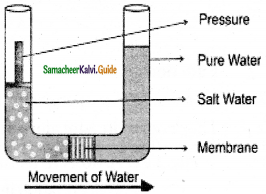
Question 4.
Difference between various plasmolysis types
Answer:
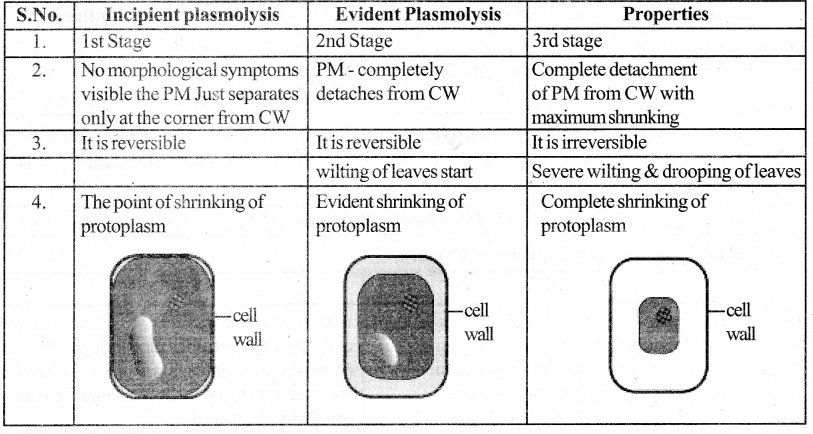
Question 5.
Define Antitranspirant.
Answer:
Antitranspirant is any material applied to plants to retard or reduce the rate of transpiration – without disturbing the process of gaseous exchange, for respiration and photosynthesis.
Eg. Colourless plastics silicone oil and low viscosity waxes.
![]()
Question 6.
What are the inducers of stomatal closure.
Answer:
- Natural antitranspirants usually induce stomatal closure
Eg. CO2 – inhibits photorespiration – thereby induces stomata! closure - Some chemicals, when applied as a foliar spray can induce stomatal closure for 2 – 3 weeks.
Eg. (PMA) Phenyl Mercuric Acetate & (ABA) Abscisic Acid.
Question 7.
Fill in the blanks in the tabulations given below
| The Study | Year | Scientist associated with it |
| 1. The concept of water potential | 1960 | …………………………………. |
| 2. Active and Passive absorptions | 1949 | ………………………………… |
| 3. Pulsation theory | 1923 | ……………………………………. |
Answer:
1) Slatyer & Taylor 2) Kramer 3) J.C. Bose
Question 8.
| Nature of membrane | Definition | Example |
| 1. Impermeable | 1. …………………………….. | suberized. cutinizedcell walls |
| 2. ………………………………. | Allow diffusion of solvent molecules, do not allow the passage of solute molecules | Parched paper |
| 3. Selectively permeable | biomembranes allow some solutes to pass in addition to solvent molecules | 3. …………………………………. |
Answer:
1) Inhibit the movement of both solvent and solute molecules
2) Semipermeable
3) Tonoplast & plasmalemma
![]()
Question 9.
Give the flow chart to cell to cell transport in plants.
Answer:
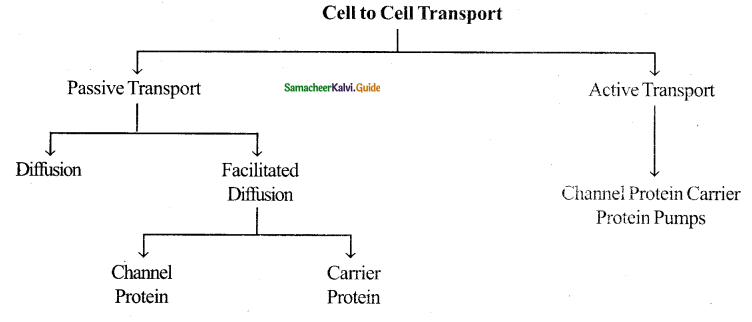
Question 10.
Explain the capillary theory of Boehm (1809).
Answer:
Capillary theory: Boehm (1809) suggested that the xylem vessels work like a capillary tube. This capillarity of the vessels under normal atmospheric pressure is responsible for the ascent of sap. This theory was rejected because the magnitude of the capillary force can raise water level only up to a certain height. Further, the xylem vessels are broader than the tracheid which actually conducts more water and against the capillary theory.
![]()
Question 11.
Explain Phloem loading?
Answer:
Definition:
The products of Photosynthesis from the Mesophyll of leaves to sieve elements of phloem is known as phloem loading. (Just like the cement sack manufactured in a factory being loaded in a vehicle to be transported the respective site)
It involves 3 steps.
Step I:
- The chloroplast has photosynthate in the form of starch or Trlose phosphate
- It is transported to the cytoplasm, where it is converted into Sucrose.

Question 12.
Explain the theory of photosynthesis in guard cells observed by Von Mohl with its demerits.
Answer:
Von Mohl (1856) observed that stomata open in light and close in the night. According to him, chloroplasts present in the guard cells photosynthesize in the presence of light resulting in the production of carbohydrate (Sugar) which increases osmotic pressure in guard cells. It leads to the entry of water from other cells and the stomatal aperture opens. The above process vice versa in the night leads to the closure of stomata.
Demerits:
- The chloroplast of guard cells is poorly developed and incapable of performing photosynthesis.
- The guard cells already possess much amount of stored sugars.
IV. 5 Mark Questions
Question 1.
Explain ‘routes’ of Water Absorption in the roots.
Answer:
- Introduction
- Root hair & other epidermal cells – By imbibition absorb water from soil –
- By osmosis moves radically & centripetally – across
- cortex
- Endodermis
- Pencycle & Xylem
There are 3 Routes
- Apoplast
- Symplast
- Transmembrane route
I. Apoplast ( GK – Apo – Away) Everything external to PM
1. Cell walls
2. Extra Cellular Space
3. Interior of dead cells (vessel elements Tracheids)
Movement is continuous exclusively through the cell wall or nonliving part of the plant without crossing any membrane.
II. Symplast (GK – Sym = within)
Entire mass of cytosol of all the living cells in a plant + plasmo desmata + inter connecting cytoplasmic channel.
In the movement water has to cross PM, to enter cytoplasm of outer root cell; then move within adjoining
cytoplasm through plasmodesmata around the vacuoles without the necessity to cross more membrane it reaches xylem.
III. Trans – Membrane Route
- Water enters a cell on one side and exits from the other side.
- It crusses 2 membranes for each cell (also through to no plast).

Question 2.
Draw & Explain the structure of Stomata.
Answer:
1. Definition:
The epidermis of leaves and green stems possess many small pores called – Stomata
2. Length & Breadth
The length – 10- 40μ The Breadth – 3 – 10μ
Number Mature leaves contain 50- 500 stomata / mm2
3. Structure
a. Guard Cells – A pair of Kidney shaped cells (semilunar) surrounded a small opening called stoma
b. Subsidiary Cells – Guard cells attached to surrounding epidermal cells known as subsidiary cells or accessory cells.
- The inner wall of guard cell is thicker
- The stoma open into an interior substomatal cavity.
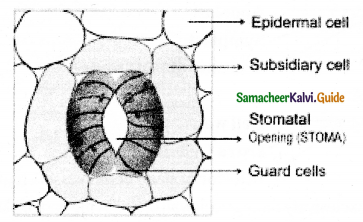
Question 3.
Explain osmosis by Potato osmoscope Experiment.
Answer:
Aim : To demonstrate osmosis by Potato osmoscope
Apparatus used: Potato tuber, beaker containing water, sugar solution and pin.
Definition:
Diffusion of water or solvent from the region of higher water potential to a region of lower water potential
is known as osmosis.
Procedure:
Take a peeled potato tuber and make a cavity inside with the help of a knife fill the cavity with concentrated sugar solution and mark the initial level.
Place this set up in a beaker containing pure water After 10 minutes observe the sugar solution level and record your observation.
Observation:
There is rise in the level of the solution. in the cavity of the tuber due to osmosis
Inference: Osmosis has occured, through the potato osmoscope
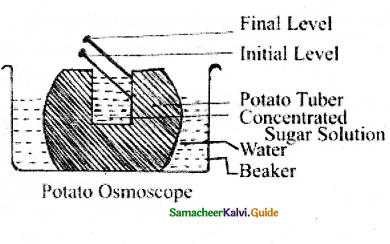
Question 4.
Measure Transpiration with Ganong’s Photometer
Answer:
Aim: To measure the rate of Transpiration with Ganong’s Potometer
Apparatus needed: Ganong’s Potometer, a twig, beaker, water, split rubber cork, and vaseline.
Procedure:
- Ganong’s Potometer is a horizontal graduated tube which is bent in opposite directions at the ends.
- A reservoir is fixed to the horizontal tube hear the wider end Reservoir has stop cock to regulate water flow.
- A twig is fixed to the wider arm through the split cork. The apparatus is filled with water with water from reservoir.
- The apparatus is made air tight by applying vaseline.
- The other bent end of the horizontal tube is dipped into a beaker containing coloured water.
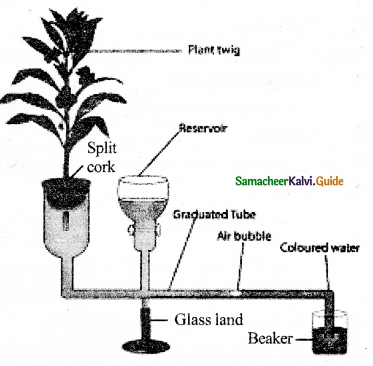
An air bubble is introduced into the graduated tube at the narrow end. Keep the apparatus in bright sunIght
and observe
Observation:
As the twig transpires, the air bubble move towards the twig.
This loss is compensated by water ohsorption from the beaker.
inference:
By the experiment we can study the rate of Transpiration and rate of transpiration is equal to the rate of water absorption.
![]()
Question 5.
Explain Mechanism of Translocation by Munch Mass flow Hypothesis
Answer:
Munch – Proposed it in 1930 Crafts – elaborated it in 1938
Definition: Organic substances (solute) move from a region of high osmotic pressure (mesophyll) to
region of low OP along TP gradient.
Example – Physical system :
Chamber ‘A’ & chamber ‘B’ made up of semi permeable membrane connected by a tube ‘T’
A – Contain highly concentrated sugar solution (hypertonic)
B – Contain dilute sugar solution (hypotonic)
A – draws water from the reservoir by Endosmosis – TP of chamber ‘A’ increased
- Continuous entry of water in to A – TP increased
- Flow of solute from chamber A to B thro TP gradient.
- The movement continues till both Aand B attain isotonic condition (equilibrium)
(However if new sugar solution added to A system will start to run again)
Example (Biological system) - Chamber A (Source) – (Equivalent to) – Mesophyll cells of leaves (High concentration of soluble food)
- Chamber B (Sink) – (Equivalent to) – Cells of stem & Roots (Consumption end)
- TubeT – (Analogous to) – Sieve tube to phloem
Steps :
1. Xylem (Reservoir) – Movement of water (Endomosis) – Mesophyll cells (TP increase)
2. Mesophyll cells (High TP) Source – enmass movement of organic solutes through Phloem by TP Gradient – Cells of stem & Root (low TP) (Sink)
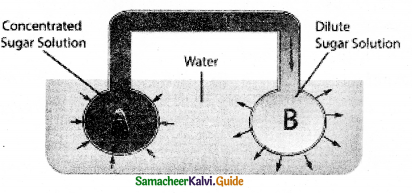
Question 6.
Explain the theory of K+ transport – or Explain the mechanism of stomatal movement
Answer:
Introduction:
Levit (1974) – Proposed it
Raschke (1975) – Elaborated it
Steps:
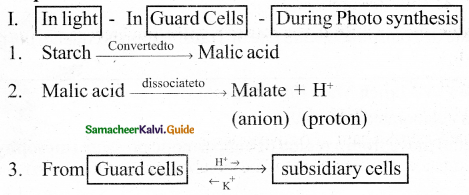
This process of exchange of ions is called Actie ion exchange ( consume ATP) or Energy
- Increased K+ ions in the Guard cells – balanced by CP ions
- Increase in solute concentration (Hypertonic) Decrease in water potential
- Water enters into Guard cells from subsidiary cells
- Wall pressure increase Turgor pressure, Turgid guard cells – fall apart & opens the stoma

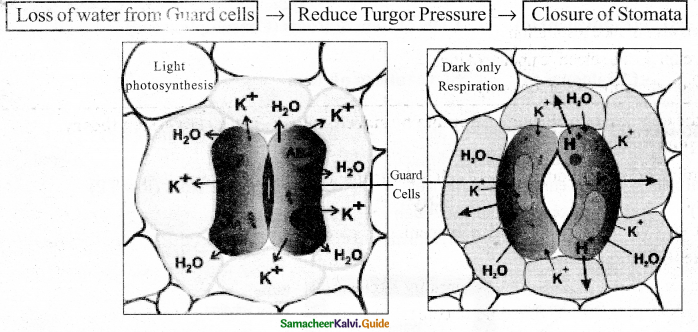
- Exit of H+
- Intake of K+
- Exit of K+
- Loss of H2O
- Uptake of H2O+
- Turgidity of Guard Cells
- Accumulation of CO2 – Lowering of pH
- Opening of Stoma.
- Activation of ABA
- Closure of Stoma.
![]()
Question 7.
Explain Cytochrome Pump Theory (or) Explain Carrier concept of Active Absorption, through cytochrome Pump theory.
Answer:
Lunde gardth & Burstom (1933)- Proposed the Cytochrome
Pump theory:
- There is correlation between Respiration & Anion absorption.
- when a plant is transferred from water to salt solution, the rate of respiration increases – known as Anion respiration – or salt respiration
The Assumptions of Cytochrome pump theory:
- The mechanism of anion and cation absorption is different.
- Anion – absorption – through cytochrome pump or chain by Active process
- An oxygen gradient is responsible for oxidation at outer surface of the membrane and reduction at the inner surface.
Explanation:
- On the inner surface, the enzyme dehydrogenase Produces protons (W) and electrons (e)

- Anions are picked up by oxidized cytochrome oxidase and transferred to the other members of the chain.
- Theory assumes the passive movement of cations (C+) along the electrical gradient created by the accumulation of anions (A–) at the inner surface of the membrane.
Defects :
-
- Cations also induce respiration
- to fail to explain the selective uptake of ions
- It explains absorption of anions only.
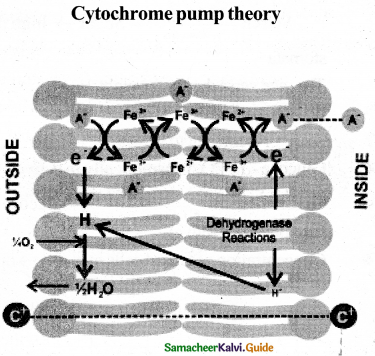
Question 8.
Explain the opening and closing of stomata by a starch – sugar – Interconversion theory.
Answer:
i) Lloyd (1908)
According to him, turgidity of Guard cell is due to interconversion of starch → sugar
- Day time:
Guard cells have sugar → so turgid → opening of stomata - Nighttime:
Guard cells have starch → so loose turgidity (become flaccid) → closure of stomata
ii) Sayre (1920)
According to him, the pH of Guard cell determine opening and closing of stomata
- Day time: Guard cells have high pH →so turgid → opening of stomata
- Nighttime: Guard cells have low pH → become flaccid → closure of stomata to be elaborate
- Day time: Utilisation of CO2. in photosynthesis → Starch into sugar → high pH → high Turgor pressure→Opening of Stomata
- Night Time: No photosynthesis, so the accumulation of CO2 → sugar to starch → low pH → decrease in TP → closure of stomata
iii) Hanes (1940)
According to Hanes – Enzyme phosphorylase is responsible for starch sugar conversion in the guard cells.
